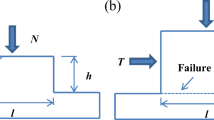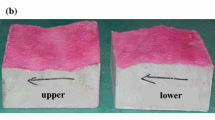Abstract
Accurate description of joint morphology is a key issue for understanding natural joint’s shear behavior and estimating its shear strength. Five sets of joint specimens with different morphological characteristics are shearing tested under different normal loads. These test results reveal that three factors, i.e., inclination angle, asperity height, and morphology of the joint back slope along the shear direction, significantly affect shear behavior. Considering the affecting mechanism of these three factors on joint’s shear behavior, a new index, named shear roughness coefficient (SRC), is proposed to accurately estimate the shear strength of rock joints. With the help of this new index, the classical JRC-JCS shear strength model can be extended from 2D to 3D surface of natural joint, which can improve estimation accuracy and reflect the shearing direction effect on joint’s shear strength.


















Similar content being viewed by others
Abbreviations
- \( {\theta}_i^{\ast } \) :
-
Apparent dip angle (°)
- ∆V ij :
-
Damage volume of the no. (i, j) triangular prisms (mm3)
- \( {A}_{\theta^{\ast }} \) :
-
Contact area ratio
- C :
-
Roughness parameter
- n i :
-
Outward normal vector of the triangle unit
- n o :
-
Outward normal vector of the shear plane
- θ i :
-
Dip angle between the shear plane and the triangle (°)
- A i :
-
The ith asperity on the joint surface
- K H :
-
Distribution characteristic parameter of joint height
- V ij :
-
Volume of the triangular prism (mm3)
- σ c :
-
Uniaxial compressive strength (MPa)
- JCS:
-
Joint wall compressive strength (MPa)
- τ p, mea :
-
Measured τp value
- JRC :
-
Joint roughness coefficient
- JRC 0 :
-
JRC value on the standard scale
- \( \overline{\delta_{\tau }} \) :
-
Average estimation errors of shear strengths
- \( {\theta}_{\mathrm{max}}^{\ast } \) :
-
Maximum apparent dip angle (°)
- V max :
-
Total volume (mm3)
- V Ratio :
-
Volume ratio
- s :
-
Shear vector
- n io :
-
Projection vector of ni
- α i :
-
Dip angle between ni and s (°)
- θ Contact :
-
Contact coefficient
- H Median :
-
Median value of joint height
- \( \overline{h} \) :
-
Average height (mm)
- ϕ b :
-
Basic friction angle (°)
- σ n :
-
Normal stress (MPa)
- τ p :
-
Peak shear strength
- τ p, cal :
-
Calculated τp value
- JRC n :
-
JRC value on the real scale
- SRC :
-
Shear roughness coefficient
References
Alameda-Hernández P, Jiménez-Perálvarez J, Palenzuela JA, El Hamdouni R, Irigaray C, Cabrerizo MA, Chacón J (2014) Improvement of the JRC calculation using different parameters obtained through a new survey method applied to rock discontinuities. Rock Mech Rock Eng 47(6):2047–2060
Bahat, D. (1991). Tectonofractography. Springer-Verlag Berlin and Heidelberg GmbH & Co. K
Ban L, Zhu C, Qi C, Tao Z (2018) New roughness parameters for 3D roughness of rock joints. Bull Eng Geol Environ:1–13
Barton N (1973) Review of a new shear-strength criterion for rock joints. Eng Geol 7(4):287–332
Barton N, Choubey V (1977) The shear strength of rock joints in theory and practice. Rock Mech 10(1–2):1–54
Barton, N., &Quadros, E. (2014). Most rock masses are likely to be anisotropic. In ISRM conference on rock mechanics for natural resources and infrastructure-SBMR 2014. International Society for Rock Mechanics
Barton N, Bandis S, Bakhtar K (1985) Strength, deformation and conductivity coupling of rock joints. Int J Rock Mech Min Sci Geomech Abstr 22(3):121–140
Beer AJ, Stead D, Coggan JS (2002) Technical note estimation of the joint roughness coefficient (JRC) by visual comparison. Rock Mech Rock Eng 35(1):65–74
Belem T, Homand-Etienne F, Souley M (2000) Quantitative parameters for rock joint surface roughness. Rock Mech Rock Eng 33(4):217–242
Brown, E. T. (1981). Rock characterization testing and monitoring. Pergamon press
Carr, J. R., &Wardner, J. B. (1987). Rock mass classification using fractal dimension. In the 28th US symposium on rock mechanics (USRMS). American Rock Mechanics Association
El-Soudani SM (1978) Profilometric analysis of fractures. Metallography 11(3):247–336
Ge YF, Tang HM, Huang L, Wang LQ, Sun MJ, Fan YJ (2012) A new representation method for three-dimension joint roughness coefficient of rock mass discontinuities. Chin J Rock Mech Eng 31(12):2508–2517
Gentier S, Riss J, Archambault G, Flamand R, Hopkins D (2000) Influence of fracture geometry on shear behavior. Int J Rock Mech Min Sci 37(1–2):161–174
Grasselli G, Egger P (2003) Constitutive law for the shear strength of rock joints based on three-dimensional surface parameters. Int J Rock Mech Min Sci 40(1):25–40
Grasselli G, Wirth J, Egger P (2002) Quantitative three-dimensional description of a rough surface and parameter evolution with shearing. Int J Rock Mech Min Sci 39(6):789–800
Hong ES, Lee JS, Lee IM (2008) Underestimation of roughness in rough rock joints. Int J Numer Anal Methods Geomech 32(11):1385–1403
Jiang Q, Feng X, Gong Y, Song L, Ran S, Cui J (2016) Reverse modelling of natural rock joints using 3D scanning and 3D printing. Comput Geotech 73:210–220
Jiang Q, Su G, Feng XT et al (2019) Excavation optimization and stability analysis for large underground caverns under high geostress: a case study of the Chinese Laxiwa project. Rock Mech Rock Eng
Jing L, Nordlund E, Stephansson O (1992) An experimental study on the anisotropy and stress-dependency of the strength and deformability of rock joints. Int J Rock Mech Min Sci Geomech Abstr 29(6):535–542
Kulatilake PHSW, Shou G, Huang TH, Morgan RM (1995) New peak shear strength criteria for anisotropic rock joints. Int J Rock Mech Min Sci Geomech Abstr 32(7):673–697
Kumar R, Verma AK (2016) Anisotropic shear behavior of rock joint replicas. Int J Rock Mech Min Sci 90:62–73
Lee YH, Carr JR, Barr DJ, Haas CJ (1990) The fractal dimension as a measure of the roughness of rock discontinuity profiles. Int J Rock Mech Min Sci Geomech Abstr 27(6):453–464
Liu H, Sterling RL (1994) A study of profile characterization for rock joints. J Rock Mech Rock Eng 27(4):189–208
Liu Q, Tian Y, Liu D, Jiang Y (2017) Updates to JRC-JCS model for estimating the peak shear strength of rock joints based on quantified surface description. Eng Geol 228:282–300
Liu Q, Tian Y, Ji P, Ma H (2018) Experimental investigation of the peak shear strength criterion based on three-dimensional surface description. Rock Mech Rock Eng 51(4):1005–1025
Maerz NH, Franklin JA, Bennett CP (1990) Joint roughness measurement using shadow profilometry. Int J Rock Mech Min Sci Geomech Abstr 27(5):329–343
Mo P, Li Y (2019) Estimating the three-dimensional joint roughness coefficient value of rock fractures. Bull Eng Geol Environ 78(2):857–866
Özvan A, Dinçer İ, Acar A, Özvan B (2014) The effects of discontinuity surface roughness on the shear strength of weathered granite joints. Bull Eng Geol Environ 73(3):801–813
Riss J, Gentier S, Archambault G, Flamand R (1997) Sheared rock joints: dependence of damage zones on morphological anisotropy. Int J Rock Mech Min Sci 34(3–4):258–2e1
Sayles RS, Thomas TR (1977) The spatial representation of surface roughness by means of the structure function: a practical alternative to correlation. Wear 42(2):263–276
Shapiro SS, Wilk MB (1965) An analysis of variance test for normality (complete samples). Biometrika 52(3/4):591–611
Song L, Jiang Q, Shi YE, Feng XT, Li Y, Su F et al (2018) Feasibility investigation of 3D printing technology for geotechnical physical models: study of tunnels. Rock Mech Rock Eng
Tang ZC, Wong LNY (2016) New criterion for evaluating the peak shear strength of rock joints under different contact states. Rock Mech Rock Eng 49(4):1191–1199
Tang ZC, Liu QS, Huang JH (2014) New criterion for rock joints based on three-dimensional roughness parameters. J Cent South Univ 21(12):4653–4659
Tatone BS, Grasselli G (2009) A method to evaluate the three-dimensional roughness of fracture surfaces in brittle geomaterials. Rev Sci Instrum 80(12):1–10
Tatone BS, Grasselli G (2010) A new 2D discontinuity roughness parameter and its correlation with JRC. Int J Rock Mech Min Sci 47(8):1391–1400
Thomas TR (1981) Characterization of surface roughness. Precis Eng 3(2):97–104
Tiwari G, Latha GM (2019) Reliability analysis of jointed rock slope considering uncertainty in peak and residual strength parameters. Bull Eng Geol Environ 78(2):913–930
Xia CC, Tang ZC, Xiao WM, Song YL (2014) New peak shear strength criterion of rock joints based on quantified surface description. Rock Mech Rock Eng 47(2):387–400
Xie H, Wang JA, Xie WH (1997) Fractal effects of surface roughness on the mechanical behavior of rock joints. Chaos, Solitons Fractals 8(2):221–252
Yan F, Pan P, Feng XT et al (2019) A fast successive relaxation updating method for continuous-discontinuous cellular automaton method. Appl Math Model 66:156–174
Yang ZY, Chiang DY (2000) An experimental study on the progressive shear behavior of rock joints with tooth-shaped asperities. Int J Rock Mech Min Sci 37(8):1247–1259
Yang ZY, Lo SC, Di CC (2001) Reassessing the joint roughness coefficient (JRC) estimation using Z2. Rock Mech Rock Eng 34(3):243–251
Yang J, Rong G, Hou D, Peng J, Zhou C (2016) Experimental study on peak shear strength criterion for rock joints. Rock Mech Rock Eng 49(3):821–835
Yu X, Vayssade B (1991) Joint profiles and their roughness parameters. Int J Rock Mech Min Sci Geomech Abstr 28(4):333–336
Zhang X, Jiang Q, Chen N, Wei W, Feng X (2016) Laboratory investigation on shear behavior of rock joints and a new peak shear strength criterion. Rock Mech Rock Eng 49(9):3495–3512
Funding
This work is financially supported by the National Natural Science Foundation of China (No. 51779251), Hubei Province Outstanding Youth Fund (No. 2017CFA060), and Scholarship for Visiting Scholars Program of Key Laboratory of Geomechanics and Geotechnical Engineering, Institute of Rock and Soil Mechanics, CAS (No. Z017007005).
Author information
Authors and Affiliations
Corresponding author
Rights and permissions
About this article
Cite this article
Song, L., Jiang, Q., Li, Lf. et al. An enhanced index for evaluating natural joint roughness considering multiple morphological factors affecting the shear behavior. Bull Eng Geol Environ 79, 2037–2057 (2020). https://doi.org/10.1007/s10064-019-01700-1
Received:
Accepted:
Published:
Issue Date:
DOI: https://doi.org/10.1007/s10064-019-01700-1




